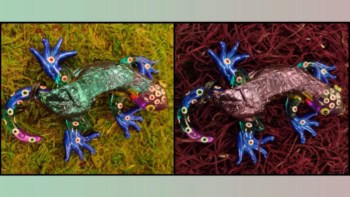The surprising optical properties of so-called ‘left-handed’ materials have been thrown into doubt by physicists in Spain and the US. Researchers in Madrid say that claims that such materials could act as perfect lenses violate the principle of energy conservation. Meanwhile, physicists in Texas say that ‘negative refraction’ in left-handed materials would breach the fundamental limit of the speed of light. But other researchers in the field stand by their earlier discoveries and dispute the new results.
In 1967 the Russian physicist Victor Veselago predicted the existence of materials with a negative refractive index. This property arises when the electric permittivity and the magnetic permeability of a material are both negative, leading to a special solution of one of Maxwell’s equations. He speculated that these materials would refract light in the opposite direction to conventional materials – hence the name ‘left-handed’ – and could also behave as perfect lenses.
Left-handed materials do not occur naturally, but several groups have successfully made them. A number of simulations and demonstrations have shown that left-handed materials can indeed behave as perfect lenses and that ‘negative refraction’ can take place, at least for microwave wavelengths.
But Nicolas Garcia and Manuel Nieto-Vesperinas of the Consejo Superior de Investigaciones Cientificas in Madrid believe that reports of perfect lensing make false assumptions about the behaviour of radiation in left-handed materials (N Garcia and M Nieto-Vesperinas 2002 Phys. Rev. Lett. 88 207403). When light shines through an ordinary lens, a fraction of it is absorbed by the lens in the form of ‘evanescent’ – or surface – waves, leading to a distorted image.
Studies suggested that these evanescent waves could be captured and amplified in left-handed materials to form a perfect image. Now Garcia and Nieto-Vesperinas say that this is impossible in practice and that – according to their analysis of evanescent waves – the waves would need to have infinite energy for this effect to take place.
At the University of Texas at Austin, Prashant Valanju and colleagues recently concluded that earlier studies of negative refraction failed to account for both the group and phase characteristics of electromagnetic waves (P Valanju 2002 Phys. Rev. Lett. 88 187401).
They analysed the different frequency components of a signal travelling through a left-handed material, and say that although phase fronts can refract in a ‘negative’ direction, the group front of the signal always refracts in a ‘positive’ direction. According to Valanju and colleagues, negative refraction of the group front would violate the fundamental limit of the speed of light, and therefore the notion of cause and effect.
But both the Spanish and the US studies are “seriously in error”, according to John Pendry of Imperial College in London, whose previous simulations suggested that negative refraction could take place in thin sheets of silver.
He says that Garcia and Nieto-Vesperinas neglected the absorption of the signal in parts of their calculation, and that he accounted for their objections in his original work (J Pendry 2000 Phys. Rev. Lett. 85 3966). In contrast, Pendry supports the calculations made by the US team, but argues that Valanju and co-workers misinterpreted their own results, mistaking the direction of the group wave front.
If it is proved that negative refraction and perfect lensing can be achieved in left-handed materials, they could be used for a wide range of applications including high-density data storage and high-resolution optical lithography in the semiconductor industry.



